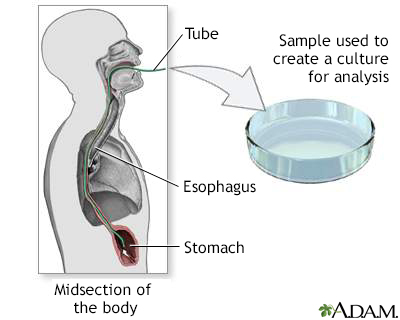Pregnancy SmartSiteTM
Culture - gastric tissue; Culture - stomach tissue; Biopsy - gastric tissue; Biopsy - stomach tissue; Upper endoscopy - gastric tissue biopsy; EGD - gastric tissue biopsy DefinitionGastric tissue biopsy is the removal of stomach tissue for examination. A culture is a laboratory test that examines the tissue sample for bacteria and other organisms that can cause disease. How the Test is PerformedThe tissue sample is removed during a procedure called upper endoscopy (or EGD). It is done with a flexible tube with a small camera (flexible endoscope) at the end. The scope is inserted down the throat into the stomach. Your health care provider sends the tissue sample to a laboratory where it is examined for signs of cancer, certain infections, or other problems. How to Prepare for the TestFollow instructions on how to prepare for the procedure. You will likely be asked not to eat or drink anything for 6 to 12 hours before the procedure. How the Test will FeelYour provider will tell you what to expect during the procedure. Why the Test is PerformedThis test may be done to diagnose a stomach ulcer or the cause of other stomach symptoms. These symptoms may include:
A gastric tissue biopsy and culture can help detect:
Normal ResultsA gastric tissue biopsy is normal if it does not show cancer, other damage to the lining of the stomach, or signs of organisms that cause infection. A gastric tissue culture may be considered normal if it does not show certain bacteria. Stomach acids normally prevent too much bacteria from growing. What Abnormal Results MeanAbnormal results may be due to:
RisksYour provider will discuss the risks of the upper endoscopy procedure with you. ReferencesFeldman M, Jensen PJ, Howden CW. Gastritis and gastropathy. In: Feldman M, Friedman LS, Brandt LJ, eds. Sleisenger & Fordtran's Gastrointestinal and Liver Disease. 11th ed. Philadelphia, PA: Elsevier; 2021:chap 52. Sugumar A, Vargo JJ. Preparation for and complications of GI endoscopy. In: Feldman M, Friedman LS, Brandt LJ, eds. Sleisenger & Fordtran's Gastrointestinal and Liver Disease. 11th ed. Philadelphia, PA: Elsevier; 2021:chap 42. | |
| |
Review Date: 10/13/2023 Reviewed By: Linda J. Vorvick, MD, Clinical Professor, Department of Family Medicine, UW Medicine, School of Medicine, University of Washington, Seattle, WA. Also reviewed by David C. Dugdale, MD, Medical Director, Brenda Conaway, Editorial Director, and the A.D.A.M. Editorial team. The information provided herein should not be used during any medical emergency or for the diagnosis or treatment of any medical condition. A licensed medical professional should be consulted for diagnosis and treatment of any and all medical conditions. Links to other sites are provided for information only -- they do not constitute endorsements of those other sites. No warranty of any kind, either expressed or implied, is made as to the accuracy, reliability, timeliness, or correctness of any translations made by a third-party service of the information provided herein into any other language. © 1997- A.D.A.M., a business unit of Ebix, Inc. Any duplication or distribution of the information contained herein is strictly prohibited. | |

 Culture of gastric...
Culture of gastric... Esophagogastroduod...
Esophagogastroduod...
